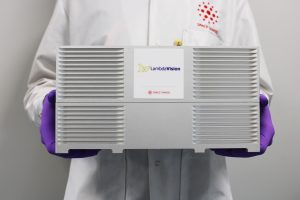LambdaVision’s slogan tells the world they are committed to “helping patients regain sight.”
The desire to help others has shaped Nicole Wagner’s career at each turn.
Wagner ’07 (CLAS) ’13 Ph.D. transferred to UConn as an undergraduate in 2004. As part of her work study, Wagner worked in Professor Robert Birge’s lab. While Wagner originally intended to go medical school, her experience in the lab changed her path.
“I got to see the dynamics of the laboratory,” Wagner says. “I got to see what was really going on behind the scenes. It was a very different, eye-opening experience for me.”
From Bench to Startup
During her time as a graduate student at UConn, Wagner got an opportunity to translate the technology she and Birge were developing in the lab into a product that could potentially help millions of people regain sight. They were developing a protein-based artificial retina for the treatment of age-related macular degeneration (AMD) or retinitis pigmentosa (RP).
We’re working to provide an elegant solution to the challenges that electrode-based devices and gene therapies are facing. — Nicole Wagner
The retina is the innermost layer of tissue in the eye. It is responsible for taking in light signals and communicating them to the brain through the optic nerve. It also provides the vision necessary for discerning objects and performing tasks like reading or driving.
With retinal degenerative diseases like AMD or RP, the cells that take in light signals start to die. This causes loss of vision over time.
The artificial retina uses a light-activated protein known as bacteriorhodopsin to replace the function of damaged rods and cones in the retina.
Bacteriorhodopsin is naturally found in the cell membrane of archaea living in salt marshes. This means the protein is highly stable and can withstand extreme heat, salt, light, and low oxygen levels.
The artificial retina, which contains layers of bacteriorhodopsin on a mesh scaffold, can be implanted directly behind the patient’s eye using a routine surgical procedure.
“We’re working to provide an elegant solution to the challenges that electrode-based devices and gene therapies are facing,” Wagner says.
When Wagner completed her Ph.D. in biochemistry in 2013, the company transitioned out of Birge’s laboratories at UConn and into the Technology Incubation Program (TIP) in Farmington.
“For me, what is really great about being part of TIP is that there are other like-minded people, there’s that sense of community,” Wagner says. “You can go down the hallway and know someone else is having a very similar challenge. It’s a great environment. We all want to see each other succeed.”
Wagner has also worked with Connecticut Innovations, CT Next (where Wagner now serves on the Board of Directors), Accelerator for Biosciences in Connecticut, the Connecticut Center for Entrepreneurship and Innovation, and MassChallenge. Wagner was recently named one of the Hartford Business Journal’s 2022 Power 50.
LambdaVision’s technology offers several advantages over existing treatments.
Current gene therapy approaches are often hit or miss, as RP can be caused by any combination of over one hundred different genes. This makes it challenging to effectively target the gene of interest.
Additionally, the efficacy of most gene therapies is greatest during the early stages of retinal degenerative diseases like AMD and RP, and early detection can be difficult. Instead, LambdaVision’s technology focuses on improving the quality of life for late-stage patients.
“Our technology is a global treatment that does not depend on the genotype,” Wagner says. “We are targeting every patient with retinitis pigmentosa.”
Vision for end-stage patients is usually limited to flashes of light. LambdaVision’s goal is to help patients in this population regain quality of life and the ability to perform daily tasks independently.
Current devices to treat these diseases have very limited resolution and resemble bulky virtual reality headsets. This hardly allows patients to distinguish between light and dark.
“You’re barely able to perform simple tasks in a high contrast environment, like sorting light and dark socks,” Wagner says. “We’re hoping to provide vision where you can actually start to navigate a room and distinguish between typical objects in a living space.”
The Final Manufacturing Frontier
Through a MassChallenge grant, LambdaVision has worked with the International Space Station (ISS), NASA, and Space Tango to explore how microgravity could improve their manufacturing process.
On Earth, manufacturing is subject to the normal forces of gravity. This can cause particles to settle or liquids to evaporate, which is not always ideal for LambdaVision’s layer-by-layer production method. In microgravity, the solutions are entirely homogenous as molecules are spread out evenly. This reduces potential imperfections and increases the overall stability of the thin films comprising LambdaVision’s artificial retina.
To create thin films for the drug product, they need to be coated with 200 layers of bacteriorhodopsin. This means that if there are any irregularities in the film, they will be compounded with each layer.
“That’s what we’re trying to avoid in this microgravity environment,” Wagner says. “If we can get very homogenous thin films from the beginning, we have less waste and a better, more stable process.”
Space Tango is LambdaVision’s implementation partner, providing the CubeLabs, or research modules, that house experiments installed aboard the ISS where the artificial retina is researched and will be manufactured.

In 2020, LambdaVision was awarded an additional $6 million from NASA to continue their research in low-Earth orbit.
LambdaVision is currently working toward manufacturing their technology according to good manufacturing processes (GMP), a necessary step on the path to FDA approval. Once the manufacturing process is in line with these standards, LambdaVision will work to develop the product, first using preclinical animal models and then moving on to human clinical trials.
Having an Impact
Wagner’s initial goal of becoming a physician was driven by her desire to help people. This desire still motivates her.
“During my early days of working on developing bacteriorhodopsin-based devices in the Birge group, we were creating technologies, like biosensors and new optical computing paradigms, that had important real-world applications.” Wagner says. “However, I am most excited by the potential clinical impact of our artificial retinal and the possibility of transforming the lives and well-being of blind patients.”
Wagner says she learns something new every day in her role, which brings together scientists, investors, and clinicians.
“Seeing that whole process makes you really appreciate everything that goes into making a drug that could be life-saving,” Wagner says. “It’s years and years of research and collaboration.”
Wagner says what keeps her going despite the challenges of starting a business and developing this technology are the stories from patients and their loved ones.
“It’s humbling to know there are people on the other end who are really waiting for what we are doing,” Wagner says. “On the days that are really, really hard, you’re inspired to keep working because there are people out there who really need this.”



